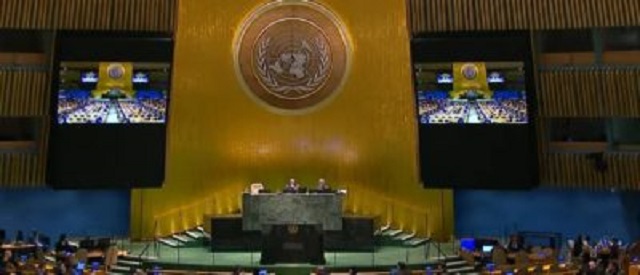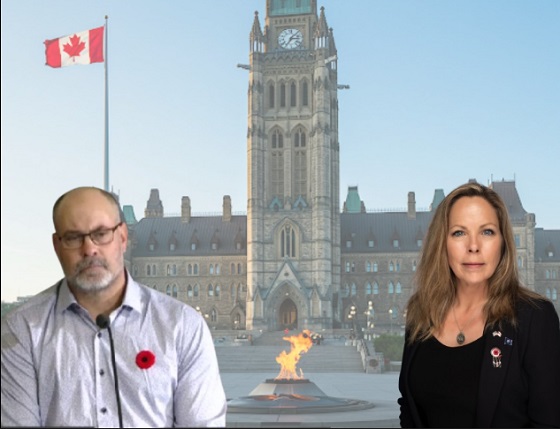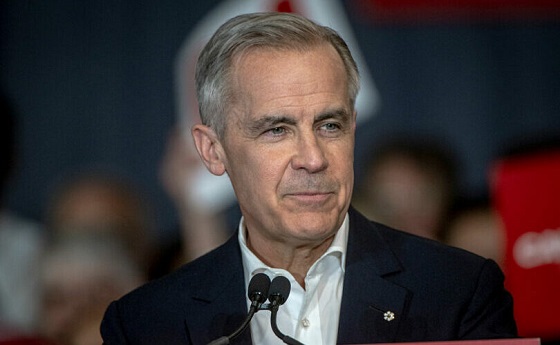Environment
The United Nations Couldn’t Be More Wrong When It Comes To Climate Change

 From the Daily Caller News Foundation
From the Daily Caller News Foundation
By JASON ISAAC
They still haven’t learned their lesson.
For decades, politicians and climate activists have been setting deadlines for humanity, brazenly preaching that we have just a few years left to stave off our fiery doom. In fact, we were supposed to have passed the deadline for taking dramatic action to save the world in 2000, 2012, 2016 2020, and 2023.
The United Nations is now ramping up their rhetoric again, with climate executive secretary Simon Stiell boldly (and, apparently, not rhetorically) asking: “Who exactly has two years to save the world? The answer is every person on this planet.”
As usual, the U.N. couldn’t be more wrong when it comes to climate change. In fact, the science to which it demands blind loyalty shows there has never been a better time in human history to be alive.
One Obama energy advisor described our culture’s understanding of climate change as having “drifted so far out of touch with the actual science as to be absurdly, demonstrably false.” He was not wrong. While celebrities, activists, politicians, and left-leaning CEOs are crying that the sky is falling, data shows that “[c]limate-related disasters kill 99% fewer people” than they did a century ago. Even though the world’s population has quadrupled over the same time period, the risk presented by mild warming has grown smaller and smaller.
Interestingly, our resilience to climate-related disasters is improving at a far faster rate than deaths from other natural disasters like volcanic eruptions and earthquakes. Clearly, the weather isn’t the culprit here.
In fact, even if the U.N. and its climate cartel were right, there is remarkably little we could do anyway. The data models their scientists use to project future warming show that even cutting every drop of oil and every grain of coal from our society would change global temperatures by at most a few hundredths of a degree. Those models, by the way, have overshot warming every time, making them a highly suspect justification for spending trillions to force our society to make dramatic changes for climate change.
In fact, new studies cataloging 420,000 years of historical geological and weather data suggest that manmade greenhouse gas emissions are not strong enough to affect global temperatures.
So many of us, in our comfortably air-conditioned and Wi-Fi-enabled lives — far removed from the blue-collar energy producers toiling every day to power our society — have forgotten just how essential fossil fuels are to our existence. Our agriculture, manufacturing, healthcare, transportation, public safety, utilities, banking, construction, entertainment and more would collapse without constant access to affordable, reliable energy.
Fossil fuels are the reason that the percentage of people living in extreme poverty has plummeted all over the world. In the pre-Industrial Revolution era, most of the world’s population lived in extreme poverty; 50 years ago it was about half the world population; today, it is less than 10%. Infant mortality, malnutrition and infectious diseases have plummeted while GDP, education, gender equality, economic freedom and life expectancy have skyrocketed.
The average child born today in any part of the world has a better chance at a long, healthy, and fruitful life than ever before — thanks, in part, to the life-saving and life-improving benefits of abundant energy.
We need only look to the pockets of the world still suffering from energy poverty to understand just how fortunate we are to live in 2024 instead of 1724. In communities without electricity — which nearly a billion people still don’t have and billions more have only sporadic access to — life expectancies still hover in the 50s and mere survival requires physical toil unimaginable to the average American.
Women walk for hours to collect unsanitary water and firewood or dung to burn in close quarters, exposing themselves to sexual assault and their whole families to deadly water-borne and lung disease. Children are fortunate to reach adulthood at all, let alone receive an education. Economic opportunity is close to nonexistent, even for men, outside subsistence farming.
Instead of protesting the fossil fuels that power our comfortable lives and spending trillions to possibly produce minute temperature change centuries from now, perhaps our world leaders should focus on solving the real problems facing real men, women, and children today. One of the easiest ways to do so is sharing the access to affordable, reliable energy we take for granted in the West.
I’ll keep embracing my high carbon lifestyle and hope that others get to do the same. See you in two years.
The Honorable Jason Isaac is CEO of the American Energy Institute and a senior fellow at the Texas Public Policy Foundation. He previously served four terms in the Texas House of Representatives.
The views and opinions expressed in this commentary are those of the author and do not reflect the official position of the Daily Caller News Foundation.
Environment
Experiments to dim sunlight will soon be approved by UK government: report

From LifeSiteNews
Dimming the sunlight poses serious dangers, including by blocking vitamin D, potentially reducing rainfall, and releasing toxins into the environment.
Experiments aimed at dimming sunlight with the stated goal of reducing “global warming” will be approved by the U.K. government within weeks, according to The Telegraph.
Professor Mark Symes, the program director for Aria (Advanced Research and Invention Agency), said the organization has planned “small controlled outdoor experiments on particular approaches” to sunlight dimming.
These trials could include “injecting aerosols into the atmosphere, or brightening clouds,” which are both Sunlight Reflection Methods (SRM). Marine Cloud Brightening (MCB) involves spraying sea-salt particles into the sky to make low-lying clouds more reflective.
It is unclear what kind of aerosols are being considered for the trials, although according to geoengineering.global, sulfate aerosols as well as black carbon, metallic aluminum, aluminum oxide, and barium titanate aerosols are “being considered for this solar radiation management approach.” Metallic aerosols in particular would raise health concerns for human beings as well as animal and plant life.
Symes has insisted to the public that the experiments won’t release toxic substances but has not specified what they will involve. “We have strong requirements around the length of time experiments can run for and their reversibility and we won’t be funding the release of any toxic substances to the environment,” he said.
Geoengineering.global admits that stratospheric aerosol injection poses dangers such as the possibility of reduced rainfall in certain areas, with accompanying “loss of crops and access to freshwater.”
According to The Telegraph, researchers have said in recent years that pollution above shipping routes has caused clouds above them to become brighter than normal, bringing about an overall dimming effect by reflecting sunlight back into the atmosphere.
While the scientific establishment often claims there is a “consensus” that the earth is warming, and, moreover, at a dangerous rate, six top international scientists released findings in 2022 that projected a cooling of the Northern hemisphere until the 2050s, and, by extension, the rest of the globe.
Most compellingly, over 1,100 scientists and professionals signed a “World Climate Declaration (WCD)“ in 2022 declaring that “There is no climate emergency,” even if the globe is warming. They point out that “Earth’s climate has varied for as long as the planet has existed, with natural cold and warm periods,” and add that “warming is far slower than predicted.”
They also note that “there is no statistical evidence that global warming is intensifying hurricanes, floods, droughts and such-like natural disasters, or making them more frequent.”
The question of global warming aside, the effects of dimmed sunlight from even short-term experiments could have detrimental effects on mental and physical health. Sunlight is a critical source of vitamin D, which is needed to help defend against infections. Those who live above the 37th parallel are already said to be exposed to insufficient amounts of sunlight for vitamin D production during the fall and winter.
Dimmed sunlight could also put people at increased risk of Seasonal Affective Disorder (SAD), a type of depression linked to reduced levels of sunlight during the winter. According to researchers, the mechanism behind SAD involves lowered serotonin levels and a disrupted circadian rhythm caused by lack of sunlight.
Censorship Industrial Complex
Misinformed: Hyped heat deaths and ignored cold deaths

From the Fraser Institute
Whenever there’s a heatwave—whether at home or abroad—the media loves to splash it. Politicians and campaigners then jump in to warn that climate change is at fault, and urge us to cut carbon emissions. But they are only telling us one-tenth of the story and giving terrible advice.
Global warming indeed causes more heat waves, and these raise the risk that more people die because of heat. That much is true. But higher temperatures also cause a reduction in cold temperatures, reducing the risk that people die from the cold. Almost everywhere in the world—not just Canada—cold kills 5-15 times more people than heat.
Heat gets a lot of attention both because of its obvious link to climate change and because it is immediately visible—meaning it is photogenic for the media. Heat kills within a few days of temperatures getting too high, because it alters the fluid and electrolytic balance in weaker, often older people.
Cold, on the other hand, slowly kills over months. At low temperatures, the body constricts outer blood vessels to conserve heat, driving up blood pressure. High blood pressure is the world’s leading killer, causing 19 per cent of all deaths.
Depending on where we live, taking into account infrastructure like heating and cooling, along with vehicles and clothes to keep us comfortable, there is a temperature at which deaths will be at a minimum. If it gets warmer or colder, more people will die.
A recent Lancet study shows that if we count all the additional deaths from too-hot temperatures globally, heat kills nearly half a million people each year. But too-cold temperatures are more than nine-times deadlier, killing over 4.5 million people.
In Canada, unsurprisingly, cold is even deadlier, killing more than 12 times more than heat. Each year, about 1,400 Canadians die from heat, but more than 17,000 die because of the cold.
Every time there is a heatwave, climate activists will tell you that global warming is an existential problem and we need to switch to renewables. And yes, the terrible heat dome in BC in June 2021 tragically killed 450-600 people and was likely made worse by global warming. But in that same year, the cold in BC killed 2,500 people, yet these deaths made few headlines.
Moreover, the advice from climate activists—that we should hasten the switch away from fossil fuels—is deeply problematic. Switching to renewables drives up energy prices. How do people better survive heat? With air conditioning. Over the last century, despite the temperature increasing, the US saw a remarkable drop in heat deaths because of more air conditioning. Making electricity for air conditioning more expensive means especially poorer people cannot afford to stay cool, and more people die.
Likewise, access to more heating has made our homes less deadly in winter, driving down cold mortality over the 20th century. One study shows that cheap gas heating in the late 2000s saved 12,500 Americans from dying of cold each year. Making heating more expensive will consign at least 12,500 people to die each year because they can no longer afford to keep warm.
One thing climate campaigners never admit is that current temperature rises actually make fewer people die overall from heat and cold. While rising temperatures drive more heat deaths, they also reduce the number of cold deaths — and because cold deaths are much more prevalent, this reduces total deaths significantly.
The only global estimate shows that in the last two decades, rising temperatures have increased heat deaths by 0.21 percentage points but reduced cold deaths by 0.51 percentage points. Rising temperatures have reduced net global death by 0.3 per cent, meaning some 166,000 deaths have been avoided. The researchers haven’t done the numbers for Canada alone, but combined with the US, increased temperatures have caused an extra 5,000 heat deaths annually, but reduced the number of cold deaths by 14,000.

If temperatures keep rising, cold deaths can only be reduced so much. Eventually, of course, total deaths will increase again. But a new near-global Nature study shows that, looking only at the impact of climate change, the number of total dead from heat and cold will stay lower than today almost up to a 3oC temperature increase, which is more than currently expected by the end of the century.
People claim that we will soon be in a world that is literally too hot and humid to live in, using something called the “wet bulb” temperature. But under realistic assumptions, the actual number of people who by century’s end will live in unlivable circumstances is still zero.
The incessant focus on tens or hundreds of people dying in for instance Indian heatwaves makes us forget that even in India, cold is a much bigger challenge. While heat kills 89,000 people each year, cold kills seven times more at 632,000 every year. Yet, you would never know with the current climate information we get.
Hearing only the alarmist side of heat and cold deaths not only scares people—especially younger generations—but points us toward ineffective policies that drive up energy costs and let more people die from lack of adequate protection against both heat and cold.
Bjørn Lomborg
-

 2025 Federal Election17 hours ago
2025 Federal Election17 hours agoMark Carney: Our Number-One Alberta Separatist
-

 2025 Federal Election20 hours ago
2025 Federal Election20 hours agoNine Dead After SUV Plows Into Vancouver Festival Crowd, Raising Election-Eve Concerns Over Public Safety
-

 Opinion1 day ago
Opinion1 day agoCanadians Must Turn Out in Historic Numbers—Following Taiwan’s Example to Defeat PRC Election Interference
-

 C2C Journal2 days ago
C2C Journal2 days ago“Freedom of Expression Should Win Every Time”: In Conversation with Freedom Convoy Trial Lawyer Lawrence Greenspon
-

 International2 days ago
International2 days agoHistory in the making? Trump, Zelensky hold meeting about Ukraine war in Vatican ahead of Francis’ funeral
-

 International21 hours ago
International21 hours agoJeffrey Epstein accuser Virginia Giuffre reportedly dies by suicide
-

 2025 Federal Election21 hours ago
2025 Federal Election21 hours agoColumnist warns Carney Liberals will consider a home equity tax on primary residences
-

 2025 Federal Election2 days ago
2025 Federal Election2 days agoCarney’s budget is worse than Trudeau’s


